blog
Book Review: Puberty by Laurence Philomène
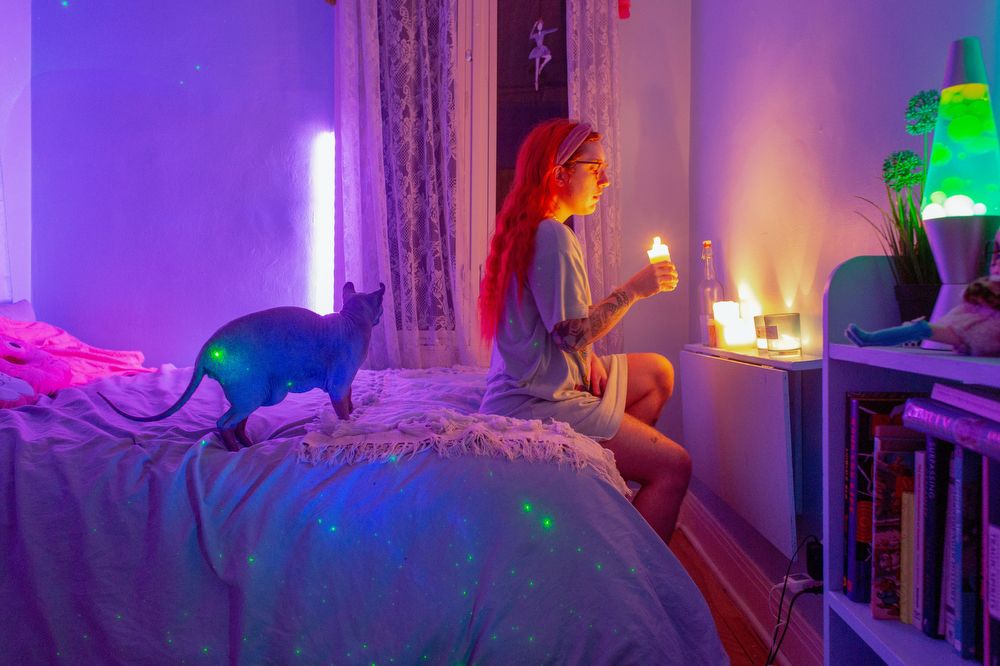
Lighting candles in my room, April 2020 © Laurence Philomène
Puberty is a self-portrait project by Laurence Philomène which looks at the intimate and vital process of self-care as a non-binary transgender person undergoing hormonal replacement therapy (HRT). Shot over a period of two years, it combines surreal colors and mundane environments to document daily moments and slow, subtle physical changes occurring during Philomène’s transition. Looking at HRT as a process without a fixed end goal, Puberty sets out to challenge viewers to consider identity beyond binaries via self-portraits and as depicted ‘through the bodies of others’.
It seems like everything you learn growing up – whether from other kids, or books you read, or from your parents – everything feels like you’re doing it wrong. Viewers online are bombarded with ideal images of how everything is going just fine – especially in the current age of constant connection, selfie-culture and over sharing. But the truth is, lots of things are not okay, and that’s okay. Authors like Judy Blume or John Green, whose novels and stories throw back the proverbial covers of youth to reveal all the bedbugs, provide the counter-argument to thinking ‘everyone else’s world is fine’: Life is messy, and that’s life. The struggles are real, but it will all be okay.
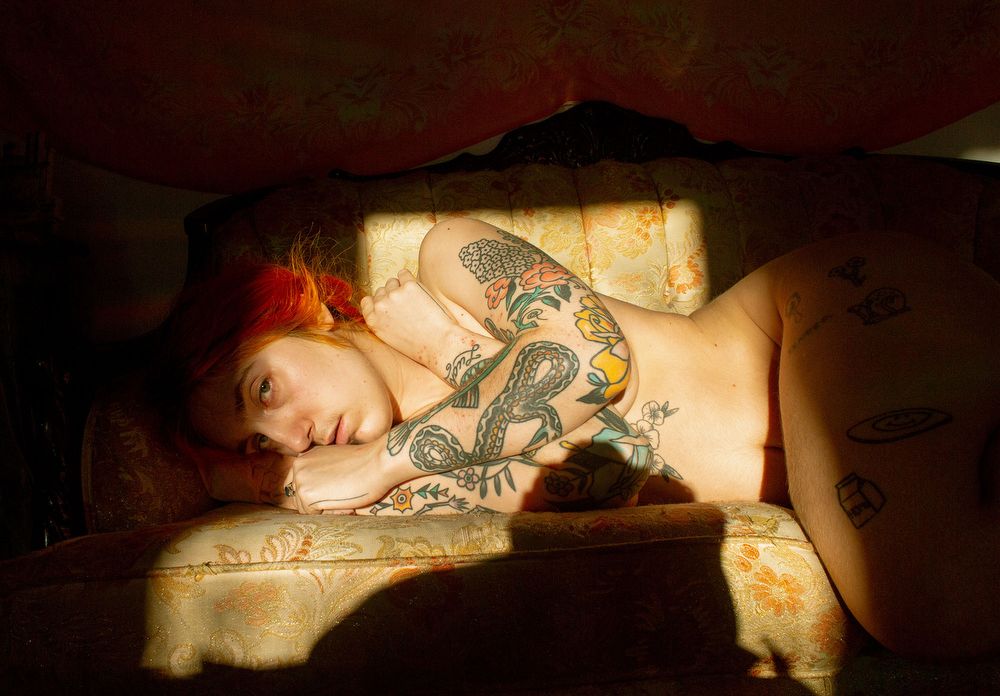
Self portrait in the afternoon light, January 2019 © Laurence Philomène
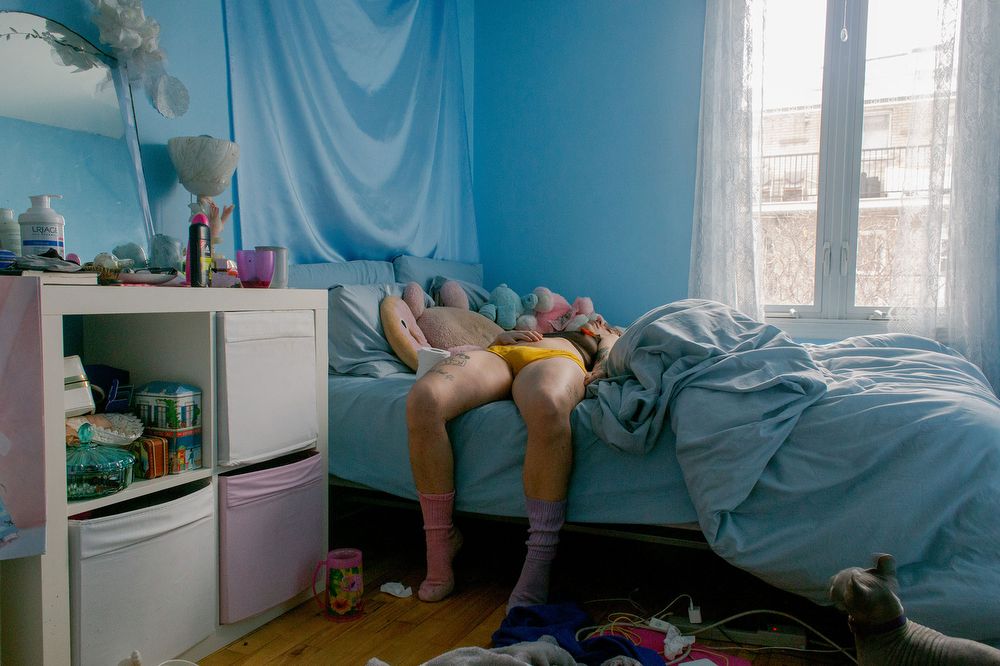
Morning scene, February 2019 © Laurence Philomène
Puberty is this transitional period when everything can feel upside down; full of awkward self-awareness, fear of judgment, fear of getting it wrong… and discovery. Laurence Philomène hits all the right buttons with Puberty. Their exploration of hormone replacement therapy in their late 20s throws them into round two of puberty. Once is enough, God forbid going through it twice before hitting 30 years old. All the aspects of puberty – being physically mature, emotionally mature, socially mature, could stretch puberty out for years and years and years.
Philomène shows us the diaristic images of their every day life over a a two year span. Images show them staring at the ceiling on their bed, a blanket of deep snow frosting a house with soft warm lights glowing in the night. Handwritten captions on super-saturated color images lead the viewer through this chronological collection. Still life images are interspersed with portraits of Philomène and their friends. “Since January 2019,” they write in the project statement, “I have been documenting the changes testosterone generates in my body and moods through daily photographs. The resulting images are simultaneously staged and candid, created by setting up a tripod in my home as I go about my routines. Set in highly-saturated domestic spaces, these photographs look at minute details of transition which are seldom represented and given access to.”
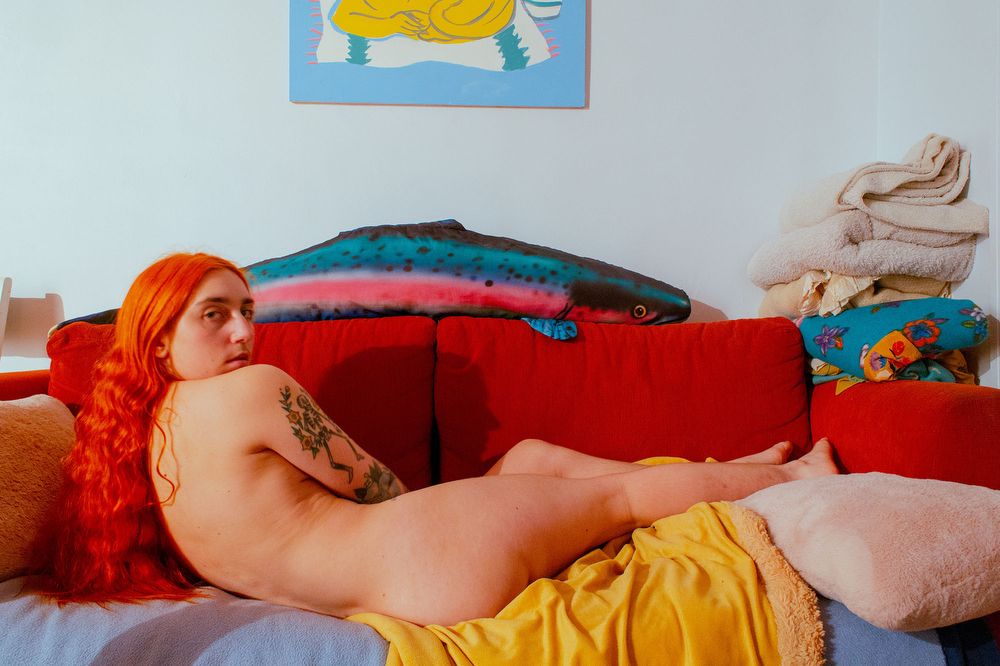
Paint me like one of your pre-raphaelite boy-girls, February 2019 © Laurence Philomène
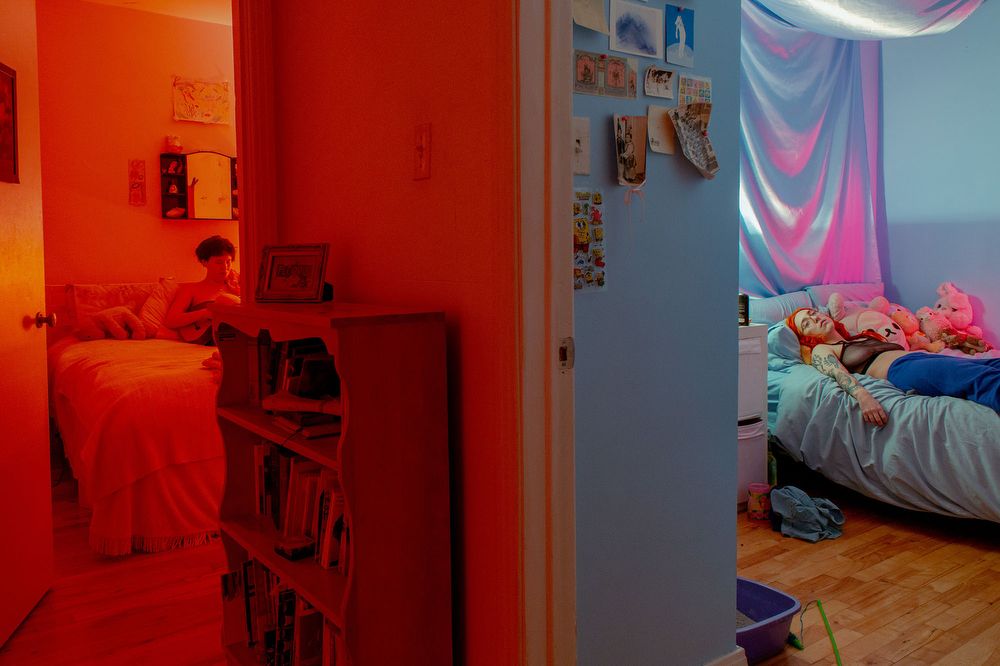
Sitting with solitude, February 2019 © Laurence Philomène
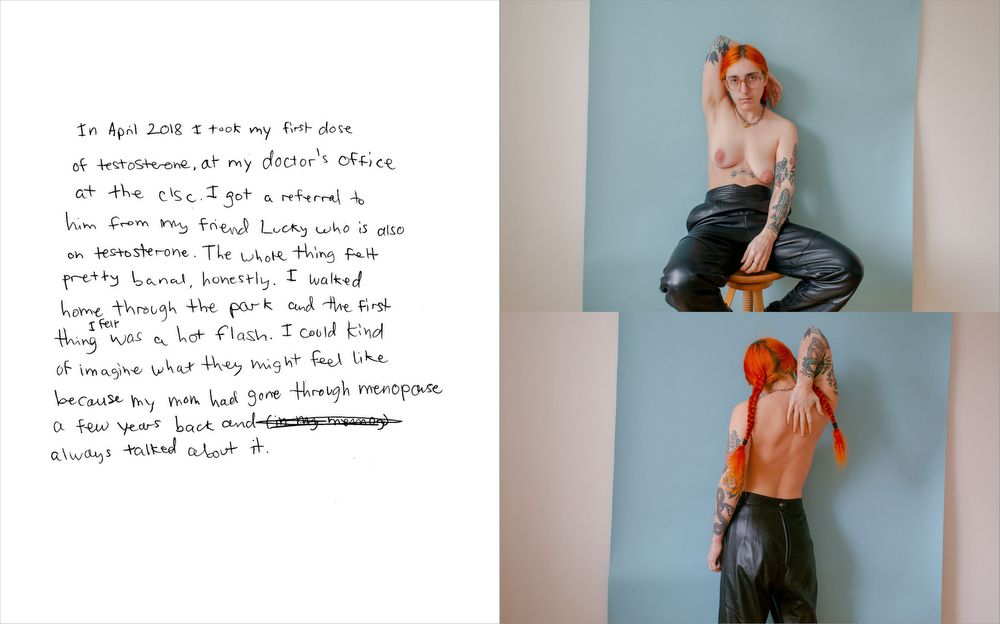
Backstory text, Self-portrait in leather pants, March 2019 © Laurence Philomène
The image “Sitting with Solitude” that shows us two people isolated in separate bedrooms (yet still joined via common space in the hallway through open doors). This scene could be construed as a metaphor for conflict within a relationship, distancing from someone while living in the same home. Or it could also be a reflection of division within oneself – whereby each person in a separate room or halves of the same whole (to take Philomène’s aforementioned portrait/self-portrait philosophy to heart). The division is further enhanced through the use of saturated warm and cool colors which split the scene in two.
Philomène also writes, “Puberty takes root in the tradition of diaristic autobiographical photography – namely Nan Goldin’s classic Ballad of Sexual Dependency, as well as the works of photographers such as Texas Isaiah, Hobbes Ginsberg, and all my trans siblings reclaiming our narratives. Having dedicated my practice to documenting non-binary lives over the last 5 years,” they continue, “Puberty allows me to dig deeper into what it means to have autonomy over our stories as marginalized individuals. In addition to this, I work with the hope of providing representation to and solidarity with future generations of queer and trans individuals as they navigate both personal joys and institutional hardship and erasure.”
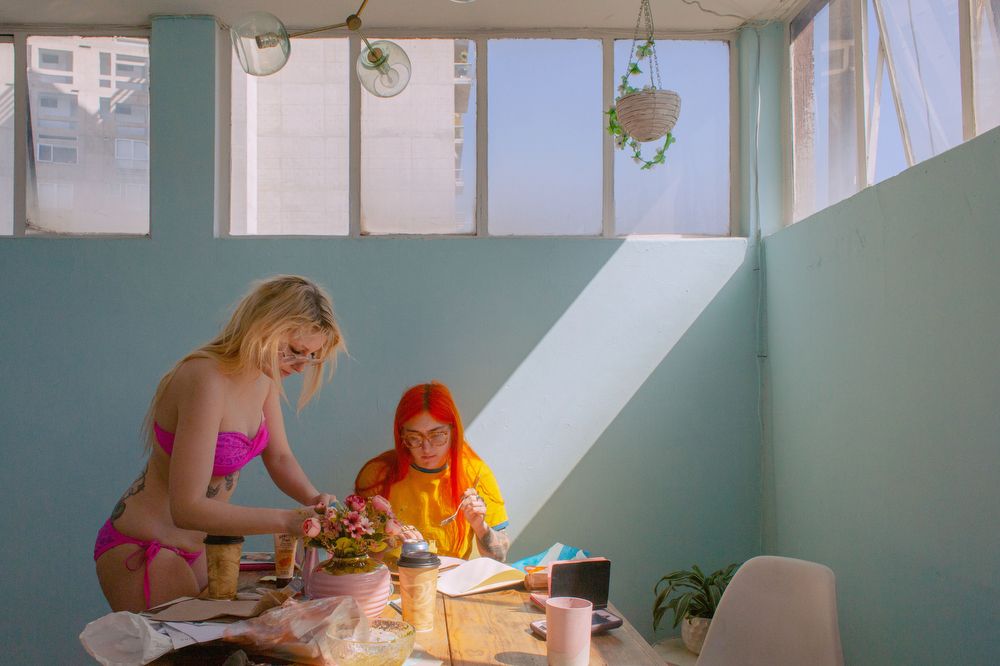
Breakfast with Billy, Mexico, February 2020 © Laurence Philomène
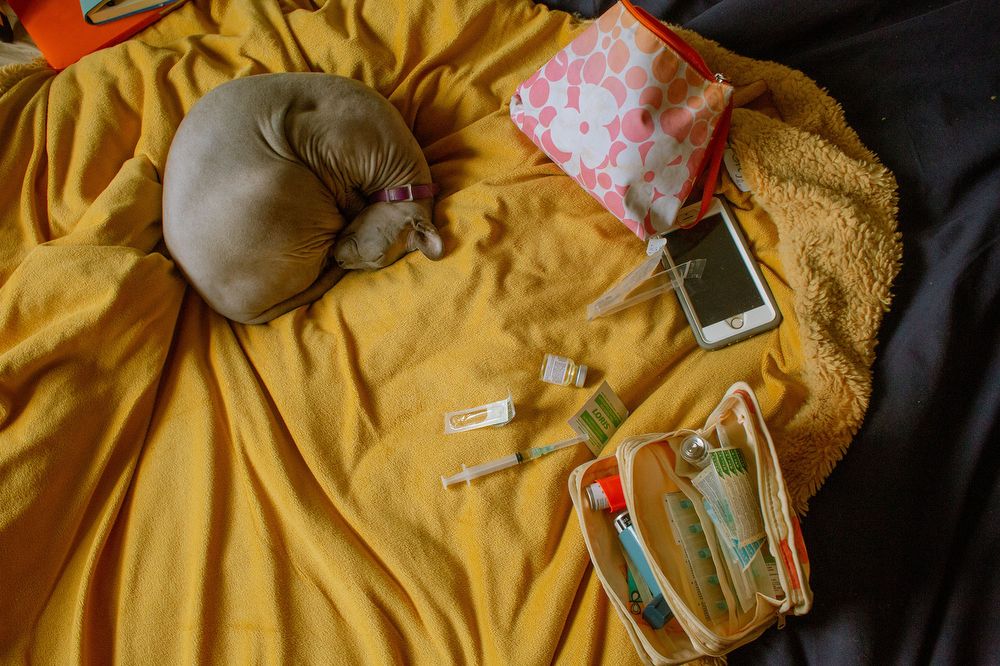
Vashti napping with testosterone, October 2019 © Laurence Philomène

Snowstorm, January 2019 © Laurence Philomène
Philomène’s series ‘Me vs Others’ (overlapping years for Puberty) also includes similar portraits and self-portraits; some which employ the use of an orange wig to match Philomène’s orange hair. Thus Philomène visually riffs on the theme of identity. One could argue this presents a theme of conformity within non-conformist groups of people. Interestingly, Nan Goldin has said that many people respond to her work in ‘Ballad of Sexual Dependency’ as applauding and representing marginalized/non-conformist people – while Goldin herself says that she and her friends and lovers were not marginalized. “We were never marginalized,” Goldin writes. “We were the world. We were our own world, and we could have cared less about what “straight” people thought of us.”
While Goldin’s ‘Ballad’ work pre-dates the selfie culture of the internet (it pre-dates the internet for that matter), there are aspects of voyeurism and exhibitionism shared in Puberty via a series of self-portraits (literally) and as depicted ‘through the bodies of others’. Philomène states that these self-portraits are at times autobiographical, and at times entirely fictional.
But in a way, don’t we invent our own narrative every day? Philomène’s fictional portraits are truthful, and speak about their sense of self and identity. In an interview with Jess T. Dugan of Strangefire Collective, Philomène writes, “Photography as an identity playground feels like a recurring theme for a lot of queer artists, I imagine because it hasn’t felt as safe for us to explore these things in the real world so art becomes an excuse to look at queerness. Right now my main aim with it really is to create imagery that makes visible and celebrates identities that have been historically marginalized.” I personally feel like this is the better way to frame the label ‘marginalized’ used here – and I say that with respect to Philomène’s Puberty and also the work of Goldin, Arbus, Lyons, or Winogrand – whose photographs of people on the margins of mainstream society are just as important and just as representational as any other photograph. Being seen is important, being represented is important – and hopefully we will eventually get to the place where it will all be okay.
::
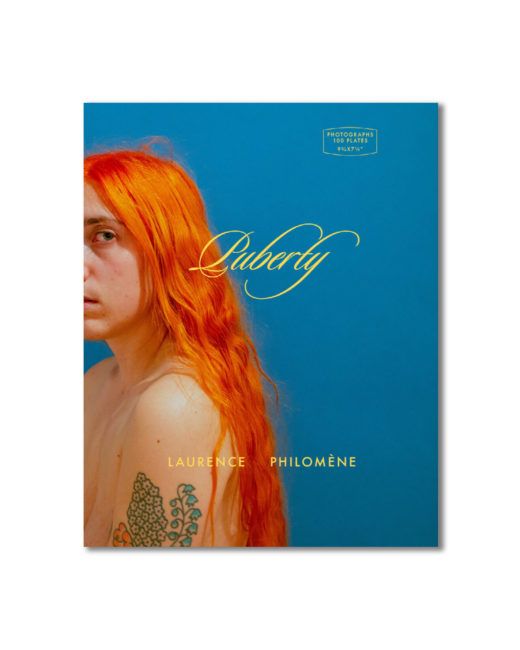
Puberty
Photographs by Laurence Philomène
Hardcover, 10 x 8 inches
288 pages
Edition of 1000
Published May 2022 by Yoffy Press
Laurence Philomène is an honoree of The 30 (“PDN 30” – 2020), recipient of the Getty Images Creatives In Quarantine Bursary (2020), the Lucie Foundation emerging artist scholarship (2019), and the 2020 Women Photograph mentorship program. In recent months, their work has notably been published in New Queer Photography: Focus on the Margins, and exhibited at Fotografiska NY and Photoville to name a few. Their work has been presented in over 40 exhibitions worldwide, including solo exhibits in Canada, Germany, France, and Poland.
Since 2016, Laurence has created commissioned work in their signature style for Netflix, BEATS, Converse, VSCO, AirBnb, and more. They were named as part of Adweek’s creative 100 list in 2018, presented their work at the 2019 Cannes Lyons festival, and served as a judge for the 2019 Getty Images Creative Bursary.
Location: Online Type: Book Review
Events by Location
Post Categories
Tags
- Abstract
- Alternative process
- Architecture
- Artist Talk
- artistic residency
- Biennial
- Black and White
- Book Fair
- Car culture
- Charity
- Childhood
- Children
- Cities
- Collaboration
- Community
- Cyanotype
- Documentary
- Environment
- Event
- Exhibition
- Faith
- Family
- Fashion
- Festival
- Film Review
- Food
- Friendship
- FStop20th
- Gender
- Gun Culture
- Habitat
- Hom
- home
- journal
- Landscapes
- Lecture
- Love
- Masculinity
- Mental Health
- Migration
- Museums
- Music
- Nature
- Night
- nuclear
- p
- photographic residency
- Photomontage
- Plants
- Podcast
- Portraits
- Prairies
- Religion
- River
- Still Life
- Street Photography
- Tourism
- UFO
- Water
- Zine

Leave a Reply